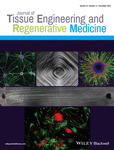Stretch growth of motor axons in custom mechanobioreactors to generate long-projecting axonal constructs
Abstract
The central feature of peripheral motor axons is their remarkable lengths as they project from a motor neuron residing in the spinal cord to distant target muscle. However, current in vitro models have not replicated this feature owing to challenges in generating motor axon tracts beyond a few millimeters in length. To address this, we have developed a novel combination of microtissue engineering and mechanically assisted growth techniques to create long-projecting centimeter-scale motor axon tracts. Here, primary motor neurons were isolated from rat spinal cords and induced to form engineered microspheres via forced aggregation in custom microwells. This technique yielded healthy motor neurons projecting dense, fasciculated axonal tracts. Within our custom-built mechanobioreactors, motor neuron culture conditions, neuronal/axonal architecture, and mechanical growth conditions were optimized to generate parameters for robust and efficient stretch growth of motor axons. We found that axons projecting from motor neuron aggregates were able to tolerate displacement rates at least 10 times greater than those by axons projecting from dissociated motor neurons. The growth and structural characteristics of these stretch-grown motor axons were compared with that of benchmark stretch-grown sensory axons, revealing increased motor axon fasciculation. Finally, motor axons were integrated with myocytes and stretch grown to create novel long-projecting axonal-myocyte constructs that recreate characteristic dimensions of native nerve-muscle anatomy. This is the first demonstration of mechanical elongation of spinal motor axons and may have applications as anatomically inspired in vitro testbeds or as tissue-engineered living scaffolds for targeted axon tract reconstruction following nervous system injury or disease.
CONFLICT OF INTEREST
D. K. C. is a co-founder and K. S. K. is currently an employee of Axonova Medical, LLC, which is a University of Pennsylvania spin-out company focused on translation of advanced regenerative therapies to treat nervous system disorders. D. K. C. is the inventor on U.S. Provisional Patent 62/569,255 related to the composition, methods, and use of the constructs described in the paper. No other author has declared a potential conflict of interest.




